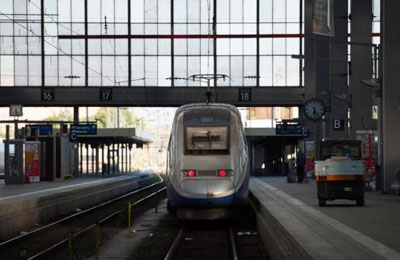
French High Speed Train (TGV) made by French train maker Alstom
leaves Munich's central railway station
Western train makers fight back with hi-tech interiors
BERLIN, September 26, 2014
Trains are likely to become more like long-haul planes, with customised carriages and tablets embedded into hi-tech seats, as Western manufacturers fight back against cheaper Chinese rivals and Europe's railways open up to greater competition.
Europe's rail passengers may feel their comfort has long been overlooked by an industry still largely in the hands of cash-strapped governments and struggling to compete with low-cost airlines as well as coaches and cars.
But that looks set to change, judging by exhibitors at this week's InnoTrans trade fair in Berlin, the world's biggest venue for rail equipment suppliers worldwide, where companies flaunted their latest innovations on a site as big as 28 soccer fields.
At the stand of France's Alstom, maker of the high-speed TGV, visitors could try out a prototype of new seats for long-distance trains, with headphones embedded in the headrest and a table converted into a multimedia tablet.
From there you could read the news, watch videos, check on your travel itinerary, order food, dim the lights and even convert the windows into a giant screen.
"Beyond speed, we're looking to make the journey a pleasant moment - less noisy, cooler, more connected and personalised," said Benoit Perrin, vice-president of marketing at Alstom Transport.
Such innovations are costly and could take years to reach trains, especially where public budgets are being reined in.
But there are powerful incentives to make them happen.
In the past few years, China's CNR and CSR have overtaken Alstom and its larger Canadian rival Bombardier to become the world's top makers of rail rolling stock by revenue.
Struggling to compete on price, the Western firms have identified passenger comfort as a potential way to fight back.
Like Alstom, Bombardier exhibited electrochromatic glass windows which can be dimmed -- by passengers or automatically -- to reduce glare and heat on a sunny day.
The market is worth fighting for. According to UNIFE, the European Rail Industry Association, the world market for rail supplies including trains and infrastructure will grow at around 2.6 per cent per annum to reach €170 billion ($216 billion) a year in 2017.
DIAMOND-SHAPED DUBAI TRAM
The focus on innovation could also appeal to Europe's train operators as they gear up for greater competition.
By 2019, the European Union wants the rail market to be fully deregulated, so passenger train operators from one country could compete for tenders in another member state.
That could lead to demands for greater customisation of carriages from rail companies seeking a competitive edge.
Alstom is already on the case. In Morocco's capital Rabat it decorated tramways with mosaic patterns, while in Reims, in France's Champagne region, it gave them a V-shape reminiscent of a champagne flute.
In Dubai, it designed them with a diamond-shaped nose and three classes: "Gold", "Silver", and "women and children".
Industry executives reckon the oil-rich cities of the Gulf are the most obvious target for off-beat designs and gadget-packed trains.
Another promising market lies in the traffic-jammed cities of southeast Asia, where authorities want people to switch to mass transit, said Yeshpaul Soor, managing director of Volo TV, a UK company that provides onboard entertainment solutions.
"They could say: why would you want to be sitting in a car? Look how good this is," he told Reuters.
Volo TV has equipped long-distance trains in Australia and Britain with individual touch screens featuring music and video on demand. For shorter journeys -- on metros, trams or intercity trains -- it offers an entertainment server to which passengers can connect remotely via their smartphone and, from there, access the same features on their own mobile screen.
Soor argues that the need for onboard entertainment is all the more pressing given that having a reliable internet connection on high-speed trains remains a challenge today.
"Passengers today don't understand why it's so hard to have access to the same kind of information on a train as they can at home," said Olivier Bourhis, France director of Nomad Digital, a provider of onboard wireless solutions recently selected by Alstom to fit German regional trains with WiFi.
This is basically because it's hard to keep a connection when you're constantly moving from one antenna to the next, and rail providers are working with telecoms firms to improve that.
"We're in a race to connectivity," Bourhis said. - Reuters







